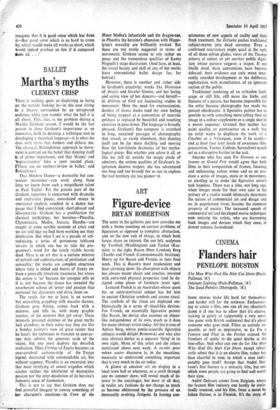Figure-device
ART BRYAN ROBERTSON
The scene in the galleries just now provides me with a theme touching on current problems of figuration as opposed to complete abstraction, and on the new cult of things, in which both forces share an interest. On our left, sculpture by Turnbull (Waddington) and Tucker (Kas- min); to the right, Bacon (New London), Berg (Tooth) and French (Commonwealth Institute). Hurry up for Bacon and French, in their final week. This is Bacon's most resplendent and least alarming show: his absorption with objects has always meant chairs and couches, invested with extra-real physical properties (and he de- signed some pieces of furniture years ago).
Leonard French is an Australian whose quest for an extra-territorial subject has led him to ancient Christian symbols and arcane ritual. The symbols of the ritual are deployed em- blematically in a series of ritual-like devices. For French, an essentially figurative painter like Bacon, the device also assumes an object- like independence of its own, much as it does for many abstract artists today. All this is true of Adrian Berg, whose poetic-scientific figurative subjects would delight Bronowski and who also uses abstract device as a separate 'thing' in its own right. More of this artist and the others mentioned above next week. A reculer pour mieux sauter discourse is, in the meantime, necessary to understand something important that is very much in the air today.
A glance at amateur art on display in a local town hall or wherever, or a stroll through any nA summer show, will reveal much of in- terest to the sociologist, but most of all that, in realist art, fashions do not change so much as become obliterated by the pressure of an incessantly evolving Zeitgeist. In forcing con- scionsness of new aspects of reality and their fresh treatment, the Zeitgeist pushes traditional
subject-matter into dead currency. Even a confirmed reactionary might quail at the sight of all those sylvan glades, views of the Thames estuary at sunset, or yet another public digni- tary whose posture suggests a teapot. If not finally dead, these conventions have become debased; their evidence can only mean inno- cently retarded development or the deliberate exploitation, with manufacture, of an ignorant section of the public.
Traditional rendering of an orthodox land- scape or still life, still more the limbs and features of a person, has become impossible for the artist because photography has made the pursuit obsolescent. A figurative painter has to provide us with something more telling than an image in a colour supplement or a single shot in a movie sequence Granted that neither has paint quality, or permanence on a wall; but no artist wants to duplicate the work of a Courbet or a Velazquez, even if he could— and at least four later levels of awareness (Im- pressionism, Turner, Cubism, Surrealism) would act as a disruptive barrier to the task.
Anyone who has seen Un Homtne et one femme or Grand Prix would agree that both films in their composition of frames, focusing and unfocusing, colour mixes and so on pro- duce a series of images, static or in movement, so startling as to make the figurative artist's task hopeless. There was a time, not long ago, when images made for their own sake in the privacy of a studio would ultimately determine the nature of commercial art and design and so, in popularised form, become the common property of society. The increased speeds of commercial art and developed movie techniques now outstrip the artists, who are borrowing back images and devices which they once, at distant remove, formulated.






























 Previous page
Previous page